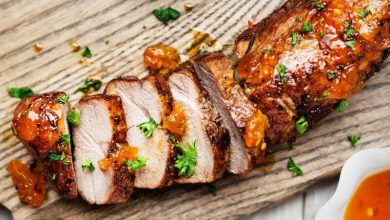🥑🍤 Avocado and Shrimp Salad 🥗
What is it?
Avocado and Shrimp Salad is a delicious and healthy dish that combines the creamy goodness of ripe avocados with the succulent flavors of shrimp. This salad is a perfect blend of textures and tastes, offering a refreshing and satisfying meal or appetizer.
History:
The exact origin of this dish is not well-documented, but it is likely a fusion of various culinary traditions. Avocado and shrimp pair well together, and over time, people have incorporated them into salads as part of contemporary cuisine. It’s become a popular choice for those seeking a light, nutritious, and flavorful meal.
Components:
- Ripe avocados 🥑
- Cooked shrimp 🍤
- Fresh vegetables (lettuce, tomatoes, cucumber, red onion, etc.)
- Fresh herbs (cilantro, parsley, or dill)
- Lime or lemon juice
- Olive oil
- Salt and pepper
- Optional: chili flakes or hot sauce for some heat
Steps to Prepare:
-
Prepare the Shrimp: You can use either boiled or grilled shrimp. If using fresh shrimp, clean and devein them. Season with a bit of salt, pepper, and olive oil, and cook until they turn pink and opaque. Allow them to cool.
-
Prepare the Salad Base: Wash and chop your choice of fresh vegetables and herbs. Lettuce, tomatoes, cucumbers, and red onions work well. Combine them in a salad bowl.
-
Prepare the Dressing: In a small bowl, mix fresh lime or lemon juice, olive oil, salt, and pepper. You can also add a pinch of chili flakes or hot sauce if you like a spicy kick.
-
Assemble the Salad: Cut the ripe avocados into cubes and add them to the salad bowl with the cooked shrimp. Gently toss the salad to combine the ingredients without mashing the avocados.
-
Drizzle the Dressing: Pour the dressing over the salad and gently toss again to coat all the ingredients with the dressing.
-
Serve: Divide the salad into individual servings and garnish with extra herbs. You can also add a lime or lemon wedge for an extra burst of citrus flavor.
Preparation Time:
The time needed to prepare Avocado and Shrimp Salad can vary depending on the cooking method for the shrimp and your chopping skills. On average, it takes approximately 20-30 minutes. Grilling the shrimp might add a little extra time, but it’s well worth it for the smoky flavor.
Enjoy your delicious Avocado and Shrimp Salad! 🥑🍤🥗
Certainly! Here are the nutrition facts and some health information for Avocado and Shrimp Salad:
Nutrition Facts (Approximate for a typical serving):
- Calories: 250-300 calories per serving (varies based on ingredients and portion size)
- Protein: 15-20 grams
- Carbohydrates: 15-20 grams
- Dietary Fiber: 8-10 grams
- Fats: 15-20 grams
- Saturated Fat: 2-3 grams
- Unsaturated Fats (healthy fats from avocados and olive oil)
- Cholesterol: 120-150 milligrams (mainly from shrimp)
- Sodium: 300-400 milligrams (varies based on seasoning)
- Vitamins and Minerals: Avocado provides significant amounts of vitamins C, E, K, and B6, as well as folate, potassium, and magnesium. Shrimp is a good source of protein, iodine, and selenium.
Health Information:
-
Good Source of Healthy Fats: Avocado and olive oil in the salad are sources of monounsaturated fats, which are heart-healthy and can help lower bad cholesterol levels.
-
Rich in Protein: Shrimp is a lean source of protein, which is essential for muscle repair and overall body function.
-
High in Fiber: The salad contains a good amount of dietary fiber, promoting digestive health and helping you feel full and satisfied.
-
Nutrient-Rich: Avocado is a nutrient powerhouse, providing vitamins and minerals that are important for overall health, including potassium, which can help regulate blood pressure.
-
Low in Added Sugar: This salad is naturally low in sugar, making it a great choice for those looking to control their sugar intake.
-
Balanced Meal: The combination of healthy fats, protein, and vegetables makes this salad a balanced and nutritious meal choice. It’s suitable for those following various dietary plans, including low-carb and keto diets.
Remember that the actual nutritional content can vary based on the specific ingredients used and portion sizes. If you have specific dietary needs or restrictions, it’s a good idea to adjust the recipe accordingly to meet your nutritional goals.



